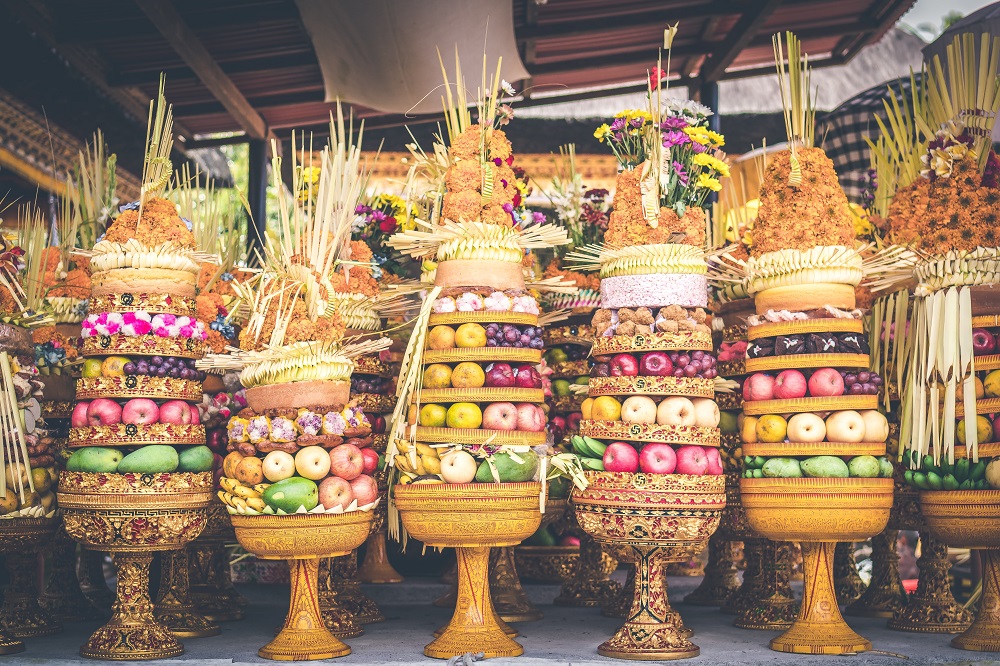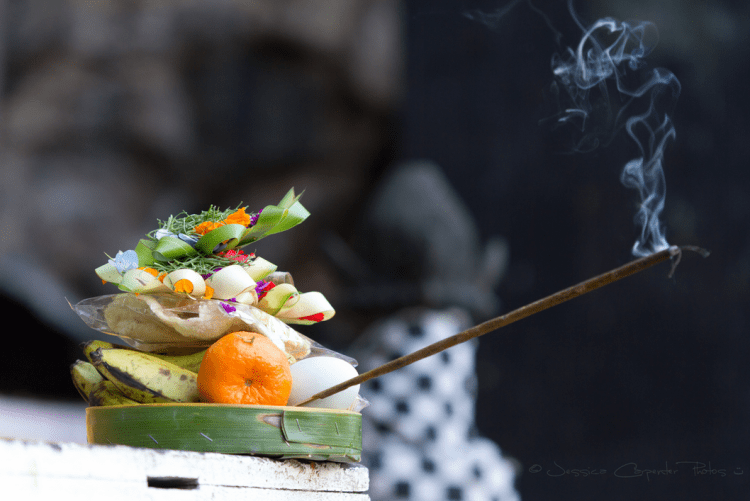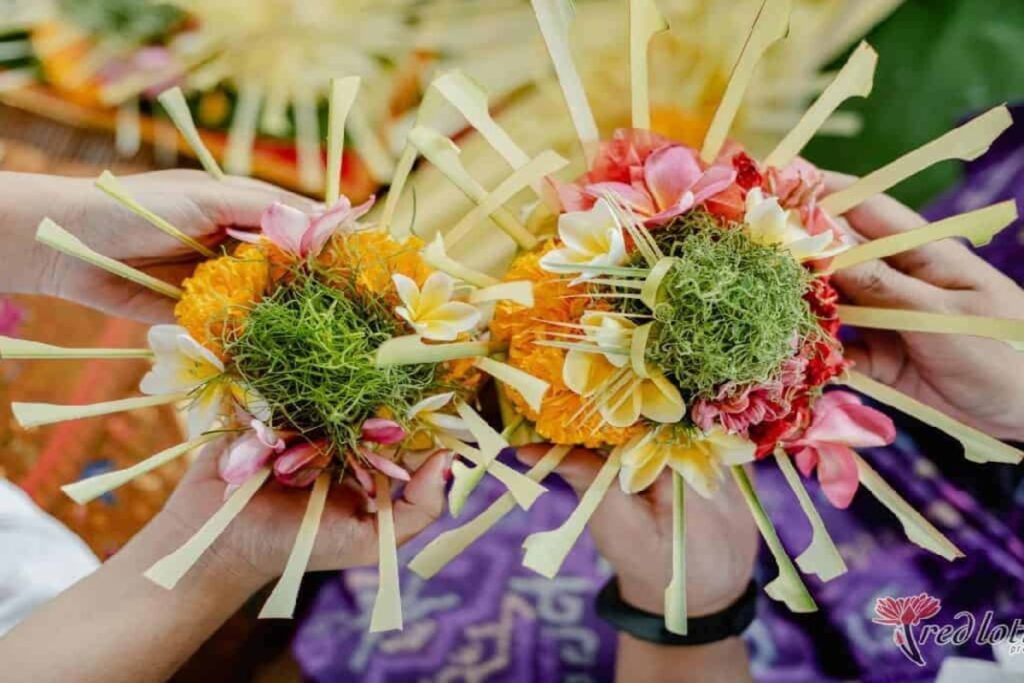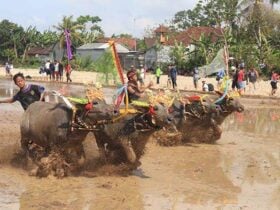Balinese Hindu Offering

Balinese Hindu Offering is a ritual offering process carried out according to Hindu religious beliefs on the island of Bali. As you know that Hindus in Bali came from Hindus in India, but in practice the Hindus in Bali adapted to local customs before the arrival of Hinduism, so you can see many differences in the process of religious ceremonies found in Balinese Hindus with Hindus in India. One of them is the process of offering to the God Almighty which is manifested by various kinds of offerings according to the customs and traditions of the people, in general, offerings that are made every day such as Segehan and Canang Sari which we often encounter on the street, in front of houses or in front of shops. It is a form of offering as a form of gratitude to God for his blessings so far that has given life, safety, health and prosperity. A procession presents offerings to God Almighty as a form of gratitude for the gift that has given life and salvation.
All You Need To Know About Balinese Hindu Offering
1. What is Balinese Hindu Offering
2. Banten is Balinese Hindu Offerings
3. Type Daily Balinese Hindu Offerings
4. Offerings on the Great Ceremony
5. The Purpose of Balinese Hindu Offerings
6. Banten is a Symbol of Harmonyings
What is Balinese Hindu Offering?
A Balinese Hindu offering, known as banten, is a symbolic gesture of devotion made by the Balinese people to honor their gods, ancestors, and spirits. These offerings are an integral part of Balinese Hinduism, a blend of Hinduism, animism, and ancestor worship. Every day, the Balinese make these offerings in various forms to express gratitude, ask for protection, and maintain harmony between the physical and spiritual worlds.
The offerings are often small and elaborate creations made from natural materials such as palm leaves, flowers, rice, fruits, and incense. They are placed in temples, shrines, homes, businesses, and public spaces to honor the gods and spirits. Each offering is believed to carry a specific spiritual significance, connecting the person making the offering with the divine forces that govern life.
Offerings are made not only to the gods of the Hindu pantheon but also to ancestral spirits, the spirits of the land, and even demons, in order to maintain a balance between good and evil forces. The act of making an offering is a sacred duty for the Balinese and is a daily reminder of their deep connection to the spiritual realm.
Banten: The Balinese Hindu Offerings
Banten is the Balinese word for offering, and it refers to the various types of offerings made in daily life and during special religious ceremonies. Banten comes in many forms, each with its own specific purpose, symbolism, and spiritual meaning. While the simplest offerings are small and made from everyday materials, more elaborate banten are created for significant religious events and ceremonies.
Banten is usually placed in small woven palm leaf trays, called canang sari, which serve as a vessel for the offerings. Each item placed in the offering has its own symbolic meaning:
- Flowers represent beauty and the different directions of the universe. For example, white flowers are placed in the east, red in the south, yellow in the west, and blue or green in the north.
- Rice symbolizes sustenance and life.
- Incense is lit during the offering to carry prayers to the heavens.
- Fruit and food offerings represent gratitude for the abundance of nature.
Banten is not limited to just these items, as offerings can also include coins, betel leaves, and other items that hold significance in Balinese rituals. The creation of banten is an artistic and spiritual practice that requires care and attention to detail, as each element must be arranged in a way that honors the divine.
Types of Daily Balinese Hindu Offerings



Offerings are made every day in Bali as part of the Balinese people’s commitment to maintaining harmony between the gods, ancestors, spirits, and the world around them. The types of daily offerings vary depending on the occasion and the intended recipient. Here are some common types of daily offerings:
1. Canang Sari
Canang sari is the most common and simplest form of daily offering in Bali. It consists of a small tray woven from palm leaves, filled with flowers, rice, and sometimes betel leaves or a coin. Canang means “offering,” while sari refers to the essence or the spirit. Canang sari is placed at family shrines, temples, businesses, and even on the street to show gratitude to the gods and seek blessings for prosperity and protection.
The act of offering canang sari is a daily ritual that is performed by women, typically in the morning or at the end of the day. The incense is lit, and prayers are said as the offering is placed in its designated location.
2. Daksina
Daksina is a more elaborate daily offering that is made as a sign of respect to the gods and ancestors. It typically includes rice, flowers, fruit, betel leaves, and sometimes eggs or cakes. Daksina is often placed in home temples or at larger community temples as part of the daily ritual of maintaining balance with the spiritual realm.
3. Segehan
Segehan offerings are made to appease bhuta kala, or malevolent spirits, in order to maintain harmony and prevent disturbances. These offerings are placed on the ground, usually near the entrance of homes or businesses, to prevent evil spirits from entering. Segehan offerings consist of rice, flowers, and sometimes food or coins, arranged in a simple palm leaf tray.
Offerings on Great Ceremonies
While daily offerings are simple, during major religious ceremonies or life events, the offerings become grand and elaborate. These offerings, known as banten upacara, are used during temple festivals, weddings, funerals, and other significant ceremonies. Here are some of the main types of offerings seen during these events:
1. Gebogan
One of the most visually striking offerings in Balinese Hindu ceremonies is the gebogan, a tall, tower-like arrangement of fruits, flowers, rice cakes, and other items. These offerings are created for temple ceremonies, festivals, and family events. The gebogan is often carried on the head by women during processions to the temple, where it is placed on the altar as a grand gesture of devotion and gratitude to the gods.
Gebogan offerings are highly symbolic, with each layer of fruits and items representing prosperity, fertility, and abundance. After the ceremony, the items from the gebogan are shared among family and community members as a blessing.
2. Tumpeng
Tumpeng is a conical-shaped offering made from yellow rice, symbolizing Mount Meru, the sacred mountain in Hindu cosmology. This offering is often presented during temple festivals and special celebrations as a symbol of gratitude and blessings for prosperity. It is accompanied by various side dishes and is considered one of the most important ceremonial offerings.
3. Sesajen
Sesajen are offerings made for ancestral spirits, often placed at family shrines or graves. These offerings include food, drinks, and flowers, and are made during ceremonies such as Ngaben (cremation ceremonies) to honor the spirits of the deceased and ensure their safe passage to the afterlife.
The Purpose of Balinese Hindu Offerings
The primary purpose of Balinese Hindu offerings is to maintain balance and harmony between the physical world and the spiritual realm. The Balinese believe that life is governed by spiritual forces, and it is their responsibility to keep these forces in balance through devotion and ritual.
1. Gratitude and Devotion
The offerings express gratitude to the gods for the blessings of life, health, and prosperity. By making offerings, the Balinese show their devotion and commitment to their religious beliefs, acknowledging that their well-being is dependent on the gods and the natural world.
2. Appeasing Spirits
Balinese Hinduism teaches that both benevolent and malevolent spirits exist in the world. Offerings are made not only to the gods but also to bhuta kala (spirits of the underworld) to prevent misfortune and maintain harmony. These offerings are meant to appease these spirits and ensure that they do not interfere with the balance of life.
3. Maintaining Cosmic Balance
Balinese offerings are deeply connected to the concept of Rwa Bhineda, the belief in the balance of opposites such as good and evil, light and darkness, and life and death. Offerings are a way to maintain this cosmic balance and ensure that the forces of Dharma (righteousness) prevail over Adharma (chaos).
Banten: A Symbol of Harmony
Banten is not just a ritualistic act but a symbol of harmony. The elements used in the offerings are carefully chosen to represent the harmonious relationship between humans, nature, and the divine. Each item in the offering—whether it’s rice, flowers, or fruit—serves as a reminder of the interconnectedness of all life.
The process of creating and presenting offerings also reinforces the idea of Tri Hita Karana, the philosophy that harmony must be maintained between:
- Humans and the divine – through devotion and prayer.
- Humans and nature – by using natural materials in offerings.
- Humans and each other – by participating in communal rituals and ceremonies.
Banten offerings are an essential way for the Balinese to live in harmony with the world around them, creating a balance that sustains life, prosperity, and spiritual fulfillment.
The Heart of Balinese Spiritual Life
Balinese Hindu offerings, or banten, are more than just decorative arrangements; they are a central element of the island’s spiritual and cultural identity. From daily offerings like canang sari to the elaborate ceremonial towers of gebogan, these offerings reflect the deep connection between the Balinese people, their gods, and the natural world.
The act of making offerings is a sacred responsibility, one that ensures the balance of the cosmos and expresses gratitude for life’s blessings. Whether you are a visitor to Bali witnessing these rituals for the first time or a local participating in the daily practice, Balinese Hindu offerings provide a powerful glimpse into the island










Leave a Review